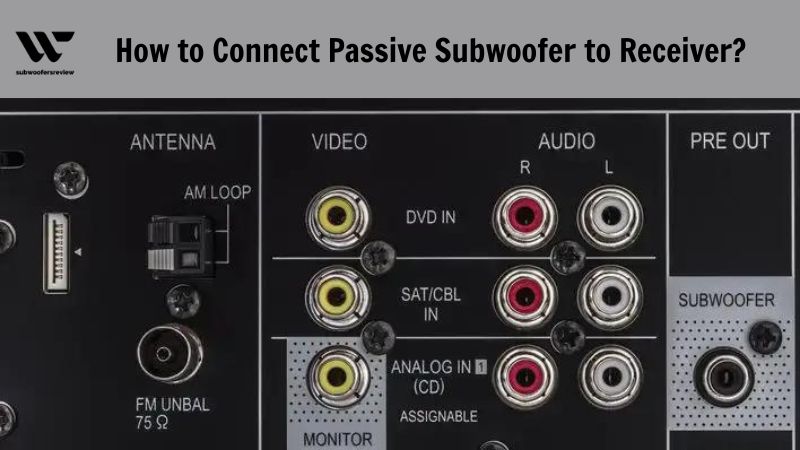Are you ready to take your audio experience to the next level? If you’re a music lover or a movie enthusiast, you know the importance of having a quality sound system. One component that can enhance your audio setup is a passive subwoofer. But how to connect passive subwoofer to receiver? In this blog, subwoofersreview will explore the steps to connect a passive subwoofer to a receiver, helping you achieve the deep, rich bass you crave.
What is A Passive Subwoofer?
A separate amplifier is necessary for passive subwoofers to perform correctly with your stereo speakers. With more personalization and control over their home entertainment system, these devices, which resemble conventional speakers, are a good choice. More study of subwoofer and receiver compatibility is needed for a passive sub. Powerless subwoofers are often lighter and more compact than amplified subwoofers since they lack an amplifier.
Can I Connect A Passive Subwoofer to Receiver?
A passive subwoofer is compatible with an AV receiver, so the answer is yes. But before you affix a receiver to a passive subwoofer, you need think about a few things. Before making a purchase, you should decide what kind of speaker you want. A large box to contain the subwoofer is not necessary if you merely need it to play music. Not much room will be needed for it.
However, a larger cabinet is required to fit the subwoofer’s size if you want to listen to a broad range of frequencies at higher volumes. It’s important to keep in mind that you don’t need to purchase a larger box if you just want a receiver to listen to music.
Sadly, there is no inbuilt amplifier in a passive subwoofer. For proper operation, it will need an external amplifier. The majority of AV receivers come equipped with a built-in amplifier that can be used with a passive subwoofer.

How to Connect Passive Subwoofer to Receiver?
Connect your Passive Subwoofer to the AVR
Connecting the passive subwoofer to the AVR is the first step you must take. In order to do this, you must also connect the ground wire and the speaker wire from your sub to the receiver’s left and right channels. Make sure they are connected correctly; otherwise, you risk damaging your speakers and possibly even yourself.
Connect the receiver to your TV or projector
Once your speakers are connected to the receiver, use an optical or HDMI cable to connect your source device—such as a DVD player—to one of the receiver’s audio inputs. An RCA cable for analog devices or a digital coax cable for digital devices can be used to connect an additional component, such as a Blu-ray player or turntable.
Set the speaker level of your receiver
When using this setting, the following step is to adjust the volume of each speaker. To make sure that all of the speakers are at the same volume, use the receiver’s volume control to individually adjust each one. There may be an automatic calibration feature on some receivers that will help make sure all speakers are set to the same volume.
Subwoofer to Receiver Connection without Subwoofer Output
Does the absence of a subwoofer output on your audio system’s components imply that your new receiver or subwoofer won’t function? No, this is not the case; nevertheless, the connecting technique will depend on how your receiver and subwoofer are connected.
RCA Cable
Use a superb subwoofer cable, such as the RCA cable over the RCA input, to connect a subwoofer to a receiver without a subwoofer output port. Even if your stereo receiver doesn’t have a subwoofer output, it most certainly has a preamp output. The left and right speaker terminals on the preamp output most likely have male and female connectors; simply connect the male to the sub and the female to the receiver. On the majority of receivers, the preamp output is found on the back.
An RCA Y converter might be required if there is just one RCA input. A Y adapter is used to convert a single subwoofer input into two stereo connectors. The input, output, and receiver connectors on your subwoofer must all be compatible with RCA cables in order to use an RCA stereo connector in an RCA jack.
Speaker level output
Use the spring clamps on the back panel of the receiver to connect a subwoofer to it if it lacks a subwoofer output. Speaker level inputs and outputs are what these are known as.
The most appropriate subwoofers are those having speaker level inputs. How many spring clips does your sub have? In that case, both the speaker and the sub-speaker will require a connection to the receiver that is shared. If it has two channels, your sub and your right and left speakers are connected to the receiver via different outputs, which is the case even if it only has one channel.
Connecting to another Amplifier (Passive Subs)
Imagine if your subwoofer didn’t require an amplifier—it would be passive. If your subwoofer is passive, another amplifier must be connected to it in order to supply power. A previously inactive subwoofer can become an active speaker by connecting two devices.
Your subwoofer and amplifier won’t operate correctly if you don’t pick the right external amplifier and connect it correctly. Even if the system can produce a signal, it won’t be able to deliver the required level of power. Your subwoofer’s crossover frequency will have an impact on what frequency it runs at as well.

Bottom Line
In conclusion, connecting a passive subwoofer to a receiver can greatly enhance the audio experience and add depth to your sound system. By following the proper steps, such as checking the impedance compatibility, using the correct cables, and configuring the receiver settings, you can successfully integrate a passive subwoofer into your setup. Remember to consult the user manual or seek professional advice if you encounter any difficulties during the process. With a properly connected passive subwoofer, you can enjoy a more immersive and dynamic audio performance in your home theater or music setup.

